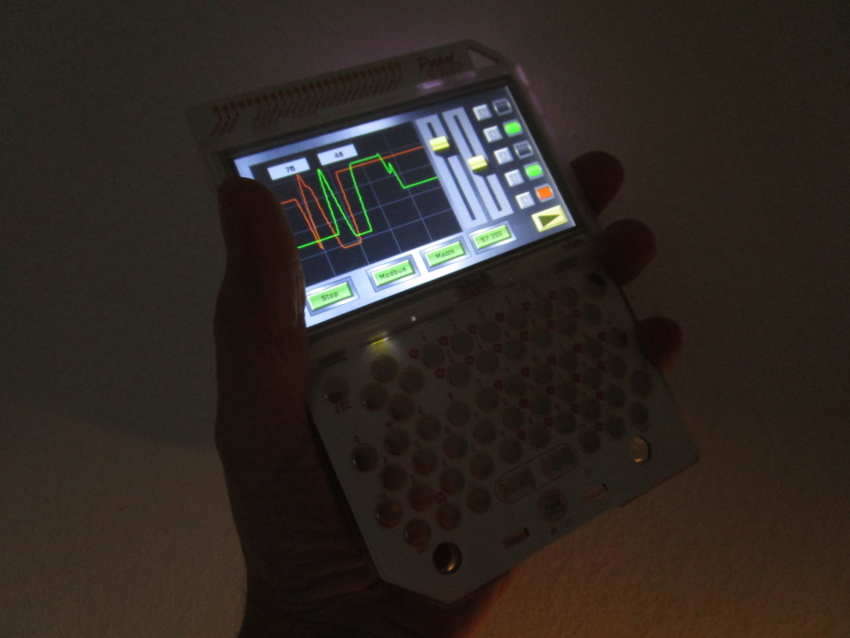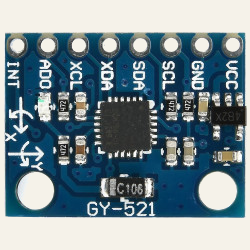
6-11-2016
Handheld Operator Station.
Testing:
- Operator Station (pwrrt 5.4.0-1 armhf)
- ChipOS 4.3
- Kernel 4.3.0-ntc
- Testing;
- Touch Screen - sensitivity & calibration (resolution 680x272)
- WiFi (stablity / distance / keep alive)
- Bluetooth
- Battery run time (50% brightness)
TBD: GPIO expansion / kernel modules
12-11-2020
I am going to try to update to Debian 10 incl. Pocket-Home based on Xorg/Awesome
14-11-2020
Upgrading the PocketChip to Debian Stretch and/or Debian Buster.
I have used the next configuration as a start.
Pocketchip image : testing-pocketchip-b667.zip
Kernel : 4.4.13- ntc-mlc
OS : Debian Jessie
The reason I prefer this is because it fits my needs and the image is available on archive.org.
The kernel and modules supports w1_gpio (onewire ), ftdi_sio (for serial USB converting ),
cdc_acm (USB modems and Arduino) and ch341 (ch341-uart converter / RS485 ), wireless works, pl2303 converter and thats enough for me
PICO-8 doesn't work, I have never used it and have no idea what it is but if you need it, maybe this link is usefull: https://www.lexaloffle.com/bbs/?tid=34009
Started with a fresh image.
Here we go......
Hook up your Wifi and open the terminal in your Pocketchip
- replace /etc/apt/sources.list -> wget http://maba.dk/sources_jessie.list
- apt-get update
- apt-get upgrade
Using ssh: Install openssh-server and login over ssh
Upgrading to Stretch:
- replace /etc/apt/sources.list -> wget http://maba.dk/sources_stretch.list
- apt-get update
- apt-get upgrade
- apt-get dist-upgrade
- replace /etc/NetworkManager/NetworkManager.conf -> wget maba.dk/NetworkManager.conf
- replace /etc/X11/xorg.conf -> wget maba.dk/xorg.conf_debian9
- replace ~/.config/awesome/rc.lua -> wget maba.dk/rc.lua
Reboot.
Voila!. A PocketChip with Debian 9 with an EOL in 2022. Without doubt with small bugs.
15-11-2020
Upgrading to Debian 10.
Based on fbdev (fps?)
Login over ssh
- replace /etc/apt/sources.list -> wget http://maba.dk/sources_buster.list
- apt-get update
- apt-get upgrade
- apt-get dist-upgrade
- replace /etc/X11/xorg.conf -> wget maba.dk/xorg.conf_debian10
Reboot
Voila! A PocketChip with Debian 10 with an EOL in 2024.
Tweak the sources.list after your needs.
First found bug: The Home button shuts down, haven't had a look at the keymap.
Can be because of the updated xkb-data..
Edit: 26.01.2021: Problem solved by Reddit user u/pernig_.
Uncomment and edit the following line in /etc/systemd/logind.conf
#HandlePowerKey=poweroff
becomes
HandlePowerKey=ignore
16-11-2020
Created a working ProviewR 5.7.1-1 development & operator station on the PocketChip (Debian 10).
07-12-2020
Tried to upgrade to Debian 11 Bullseye.
- kernel :4.4.13-ntc-mlc
Result:
- Xorg, pocket-home, WIFI working without problems
25-01-2021
Many moons ago I used a CHIP in combination with a 1-wire DS18B20 as a temperature logger.
Worked great. But later on I wanted to use a PocketCHIP because it has a LCD screen. So the graph was directly visible. I thought the PD2/LCD-D2 pin was in use of the LCD screen. So, I started the fight with device-tree-overlays, dts, dtb, udev, kmod, kernel code, datasheet R8 etc. etc.
Sometimes, life, is not that difficult as it seems. PD2/LCD-D2 is not in use at all. I hooked the data-line directly to the pin between the CHIP/PocketCHIP. Connected 5V and GND and the sensor is In /sys/bus/w1/devices visible. No problems with the LDC screen at all.
11-04-2021
Starting to build a cheap experimental spectrum analyzer for industrial vibration with the PocketCHIP, MPU-6050 / ADXL337, Arduino / Teensy and Python.
As reference I will use a SKF handheld pen (machine condition advisor) with the possibility to measure an overall velocity speed (mm/sec) and envelop bearing analysis (gE). Price $2000.
I consider this as a mission impossible to reach the quality of expensive equipment used in the industry. But as usual time will learn......
20-04-2021
Bought online a MPU-6050 for 3 Euro.

Data sheet: link
Now I have 2 possibilities. Use an AVR or directly using the I2C I/O header on the PocketCHIP.
3.3V, GND, I2C-SDA and I2C-SCL.
- MPU6050 can have a sample rate of 1 kHz for the accelerometer.
1-12-2021
Time flies. It's winter again.
Now what? Bad news: the world became mad. Good news: there is a new image for the PocketCHIP based on Debian 11 and slc emulation based on mainline Linux.
You can find it on Reddit u/macromorgan.
Got it running including a Proview Development station based on ProviewR is 5.9.0-1. Not always in the mood to upload projects but I will try to get my act together.
(Edit 26.12.2021 upload PocketCHIP encoder wheel)
20-12-2021
Ordered a 805M1-0020-01 to combine the Pocketchip and a Teensy 4.0 to measure vibration, in first case, with pyqtgraph, With this sensor it must be possible to observe vibration with max 4 kHz (8 kHz sensor and FFT).
The serial speed of the Teensy 4.0 is the USB speed (baud rate in a sketch will be ignored). Lots to think about. The host side (PocketCHIP) is something to worry about. But creating 4000 samples/sec in a *.txt file seems to be possible. So there is still hope...
08-01-2022
Found finally something, in a second hand shop for 2 Euro, for the building process. The new destination of Teensy 4.0 and the 805M1-0020 will become inside.......:

- 805M1-0020.01
- Sensivity 95.37 mV/g@80Hz
- Bias voltage 2.52.Vdc
16.01.2022
Slowly pieces are falling on place. First test on my 23 years old Skoda felicia.
Youtube: https://www.youtube.com/watch?v=zA3K87FiAh4
18.01.2022
Did a small and quick test if it was possible to save 8000 samples/sec (cat /dev/ttyACM0) on the file system of the PocketCHIP. This works without problem. To protect the NAND I will use in the future a small ramdisk and transfer it by using WIFI.
This means I can save samples to investigate later.
Data sampling at 8000 samples/sec for a period of 77 seconds (616000 samples in theory)
Video: video
A $ wc -l datafile.txt gives 616680 lines from the file saved in a 10MB ramdisk on the PocketCHIP. Used a cocktail of bash and sed. Created a second column for the time stamps and used Gnuplot.to plot the next result:
